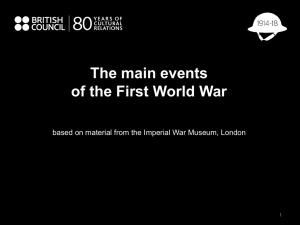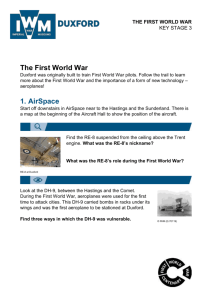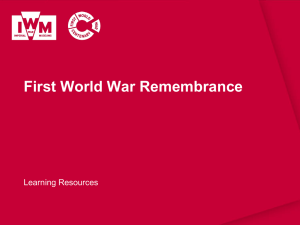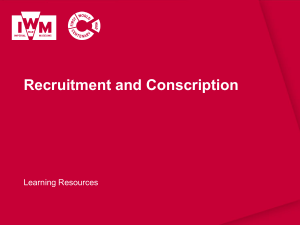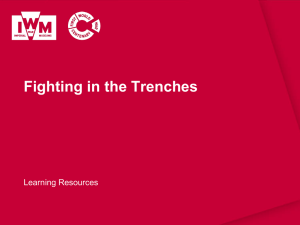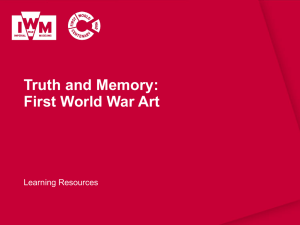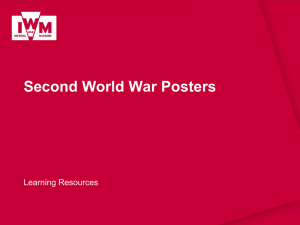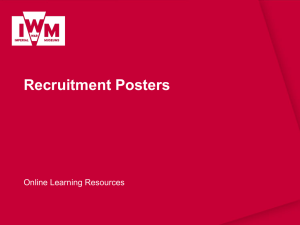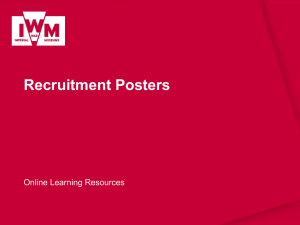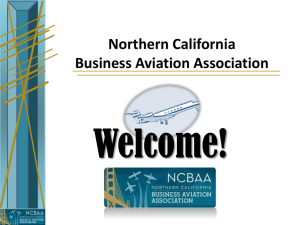PowerPoint Template 3 October 2011
advertisement
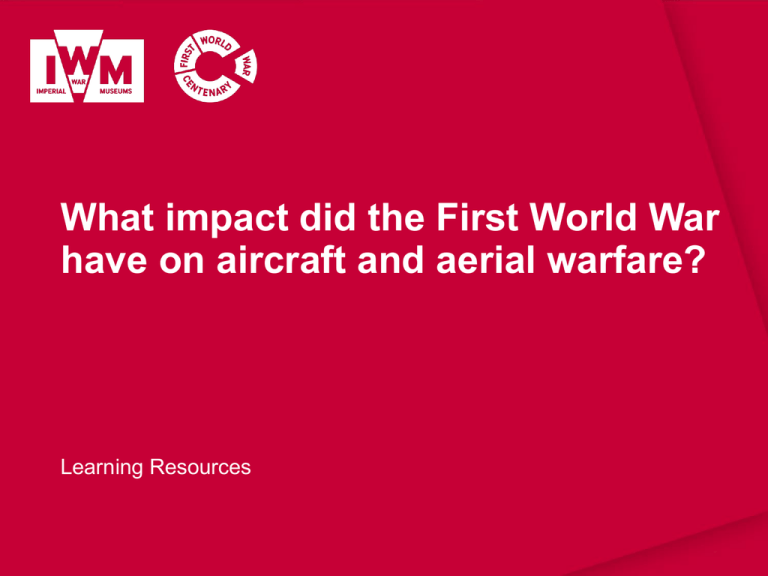
What impact did the First World War have on aircraft and aerial warfare? Learning Resources IWM Learning Resources: Terms of Use • The images in this resource can be freely used for non-commercial use in your classroom subject to the terms of the IWM’s Non Commercial Licence: http://www.iwm.org.uk/corporate/privacy-copyright/licence • You can use the full presentation or use individual slides within other presentations for use within school and to share with other teachers for their non commercial use as well. • You can print the images out up to A4 size if you wish to use hard copies with your class. • Each image comes with an attribution statement, which must be included wherever the image is used. For example, © IWM (Art.IWM ART 1179). • Every effort has been made to contact all copyright holders. IWM will be glad to make good any error or omissions brought to their attention. • By downloading this PowerPoint and using these images you agree to these terms of use, including your use of the attribution statement specified for each object by IWM. 1. What role did aircraft play at the outbreak of war? © IWM (Q 66016) B.E.2. biplane At the start of the First World War, aircraft like the B.E.2 were primarily used for reconnaissance. Due to the static nature of trench warfare, aircraft were the only means of gathering information beyond enemy trenches, so they were essential for discovering where the enemy was based and what they were doing. © IWM (FLA 394) Message Streamer These early aircraft were not fitted with radio sets, but messages about enemy troop movements needed to be communicated quickly. Pilots could either drop messages in weighted bags or use message streamers to drop messages to forces on the ground. This message streamer was dropped on 9 September 1914 during the Battle of the Marne. © IWM (PHO 26) Reconnaissance Cameras As trench systems developed and became more complex, it became harder for pilots to accurately record what was happening on the ground and formal aerial photography was introduced early in 1915. The first experimental photographs were taken by hand, but aerial reconnaissance was most effective when using cameras which were attached to the aircraft, like this C Type camera. © IWM (Q 8533) Aerial Photographs Aerial reconnaissance was a dangerous job. Taking photos of enemy positions required the pilot to fly straight and level so that the observer could take a series of overlapping images. This made them an easy target. Here we can see a series of overlapping images being turned into a larger map of the German lines near Arras in February 1918. 2. How did air-to-air combat develop? © IWM (AIR 232) Projectiles At first most aircraft were unarmed, although some pilots did carry weapons with them including pistols and grenades. These were of limited use, however, as the body of the aircraft itself made it difficult and dangerous to fire any weapons. At the same time crude attacks were made on troops on the ground. Darts like these and other dangerous objects were used by both sides. They were usually dropped in bundles from aeroplanes, as this method ensured a wide dispersal. © IWM (MOD 349) A model of the Fokker Eindecker As the importance of aerial observation grew, both sides developed tactics to try and shoot down enemy aircraft and to protect their own. By 1915, forward-firing machine guns were being fitted onto aircraft, but the real breakthrough came with the invention of an interrupter mechanism which allowed machine guns to fire through moving propeller blades. The first one was fitted to the Fokker Eindekker, like this model. © IWM (Art.IWM ART 3071) Air-to-air combat Throughout 1916 and 1917 aerial warfare developed from lone fighting to ever larger formations of aircraft and patrols. Patrol leaders would try to give themselves an element of surprise by positioning themselves above the enemy before attacking. At this point the formations would break up into individual dog fights. 'Air aces' were celebrated as heroes and used for propaganda by their governments. 3. How much training did airmen receive? © IWM (HU 94502) Insufficient preparation Some men had only a few hours of training before being sent on active missions due to an ever increasing demand for pilots. As a result, the length of basic training was minimal so it was important that their instruction was easy to understand. This short training led to heavy losses, as inexperience in the air often proved fatal. © IWM (Art.IWM PST 5277) Popular post Many saw being a pilot as a glamorous role, which would take them away from the front lines. Aviation attracted young, energetic recruits who were keen to be trained in this new way of warfare. As aircraft became more sophisticated they were seen as the cutting edge of new technology . Air to air combat developed as stability gave way to manoeuvrability and aircraft became more challenging to fly. 4. What type of people were pilots during the First World War? © IWM (Q 67780) The Red Baron Manfred von Richthofen was born into an aristocratic Prussian family in 1892. After serving in the German Army on the Western Front, he transferred to the air service in May 1915. He became the highest-scoring ace of the war with 80 official victories.and was later given command of the 'Flying Circus', a unit comprised of Germany’s elite fighter pilots. He was killed in action in April 1918 and buried by the British with full military honours. © IWM (Art.IWM ART 2364) Segeant Mottershead by Cowan Dobson Thomas Mottershead was working as a mechanic at the outbreak of war and enlisted in the Royal Flying Corps in August 1914. In January 1917, he was on patrol with his observer, Lieutenant Gower, when they encountered two German fighters. During air-to-air combat their aircraft caught fire, but Mottershead flew back over British lines, manoeuvring the aircraft in such a way as to prevent the flames harming Gower. The badly damaged aircraft collapsed on landing, throwing Gower clear, but trapping Mottershead in the burning wreckage. He died in hospital as a result of his injuries. He was the only Non-Commissioned Pilot to be awarded the Victoria Cross. © IWM (Art.IWM ART 2979) Major J B McCudden by William Orpen James McCudden joined the Royal Flying Corps as a mechanic in 1913, when he was just 18 years old. He went on to become one of the highest scoring British fighter pilots of the First World War, with 57 victories . McCudden was awarded the Victoria Cross in the spring of 1918 and after a brief rest was posted back to the Western Front to take control of his own squadron. He was killed in a flying accident on 9 July. 5. In what other ways did aerial warfare develop? © IWM (Q 67698) Disrupting the enemy Aircraft were also used to support ground troops. Ground attacks were aimed at disturbing enemy forces at the front, often during active battles. During ground attacks explosives, such as grenades and bombs, were dropped from a low altitude to ensure accuracy and machine guns were fired at targets on the ground. © IWM (Q 27521) Bombing Tactical aerial bombing, or the hitting of targets on the battlefield, became an important part of the war. Bombing of both military targets and more strategic objectives, such as factories and bases on the home fronts, were soon a common occurrence. This aerial photograph shows British bombs falling on to a target behind enemy lines. © IWM (Q 67529) Bristol Braemar Mk. I Aircraft became larger as the need for bombers grew. These aircraft could carry large quantities of explosives to drop on strategic targets, like factories and dockyards. They depended on long range and reliability as targets were often well behind enemy lines. By the end of the war aircraft had developed and improved dramatically. 6. How did aerial bombing change things on the Home Front? © IWM (Art.IWM PST 12052) Danger at home From 1915, air raids by aeroplanes and airships brought the realities of war to the home front. They became a common threat with attacks aimed at both civilian and industrial areas. The use of Zeppelin airships caused fear throughout Britain and the government used this fear to help the recruitment drive. Incendiary ammunition that could shoot down airships was eventually developed making defence easier, but air raids continued until the end of the war. © IWM (Documents.5508) Zeppelins Early British air defences were inadequate against German attacks and many raiders returned home untouched. This letter was written by Patrick Blundstone in 1916. It describes the night Lieutenant William Leefe Robinson became the first person to shoot down an airship over Britain, using a combination of explosive and incendiary bullets to pierce the airship’s skin and set fire to leaking gas. © IWM (Documents.5508) Zeppelins Early British air defences were inadequate against German attacks and many raiders returned home untouched. This letter was written by Patrick Blundstone in 1916. It describes the night Lieutenant William Leefe Robinson became the first person to shoot down an airship over Britain, using a combination of explosive and incendiary bullets to pierce the airship’s skin and set fire to leaking gas. What impact did the First World War have on aircraft and aerial warfare? Learning Resources
